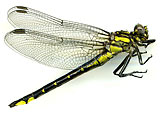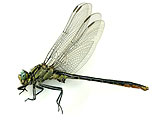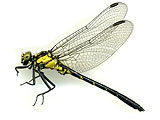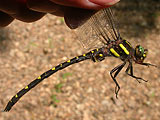
Closer to home
By the end of May, dragonfly activity finally begins to warm up in the Northeast. I need reference for quite a few species throughout the region so from my home in southern New York State I have begun to take short day trips in pursuit of species. Many are not particularly rare, and most I have seen but not collected or adequately documented. Before this project I was perfectly satisfied with finding and perhaps getting a picture of a male. In many cases I simply never looked for females (which are often harder to find since they generally do not arrive at the water until they are ready to breed). As a result I do not get to see or study them very well.
I spent three days looking for females of Unicorn Clubtail, Arigomphus villosipes. This is a very common species but I can't even recall seeing a female in the field while males are easily found perched along pond shores. During a Bioblitz in northern Westchester Co. NY (sponsored by the Bedford Audubon Society) I watched as a female suddenly appeared at the pond I was surveying and was immediately tackled by two males. They tumbled into the grass but before I could reach them, a tandem pair emerged and flew up a steep hill and into the trees. I waited along with a half dozen male Unicorn Clubtails but never did see her come down to lay her eggs that day and I still need to catch one.
I was more fortunate looking for the other local Arigomphus species, furcifer, the Lilypad Clubtail. Males were again plentiful at one of my favorite spots, Lily Lake in Rockland Co. NY but females were scarcer. I flushed up a couple of females in nearby vegetation and watched helplessly as they flew away from me. I finally caught one foraging along a trail.
Out west in Sussex Co. NJ, I collected Spine-crowned Clubtails, Gomphus abbreviatus, finding numerous males and females along a river bank. I spied another female in the grass and almost passed her up thinking it was just another Spine-crowned. To quote accomplished odonatologist Carl Cook, "Never turn down a female," so without really examining her I netted and collected her. Later that evening as I was photographing and scanning my specimens, it was suddenly apparent that she was slimmer than the Spine-crowned Clubtails. Her pattern was similar but her figure and parts were not and identified her as a Rapids Clubtail, Gomphus quadricolor, and a female I needed.
However males can be difficult as well. In anticipation of doing the Peterson dragonfly guide I started to do some local collecting and scanning last summer. I saw and caught dozens of Clamp-tipped Emeralds, Somatochlora tenebrosa, all of which were females until I finally caught a lone male. This year I targeted getting a male Southern Pygmy-Clubtail, Lanthus vernalis. I have seen this species on a number of streams in my home county of Westchester, NY but in recent years have had difficultly locating them. This year I would usually find at least one male per day, usually up in a tree in a sunny spot by the stream, and watch it fly from perch to perch until he was gone. Sid Dunkle in Dragonflies through Binoculars, described them as "unwary," an attribute that I'm pretty sure to omit in my book. I finally caught a not quite mature male in a field.
And then there are a couple species I have failed so far to get either sex. There are a couple of genera that promise to be particularly difficult to document. Ophiogomphus is one. I have already failed to find Appalachian Snaketail, Ophiogomphus incurvatus for the year, and I have only managed to find males of Edmund's and Westfall's Snaketails, O. edmundo and O. westfalli respectively. I went out to Morris Co. NJ looking for Brook Snaketail, O. aspersus. As I got out of the car, a male Snaketail sat on top of a stalk of grass. But he was gone by time I could assemble my net and I never saw another individual the rest of the day.



